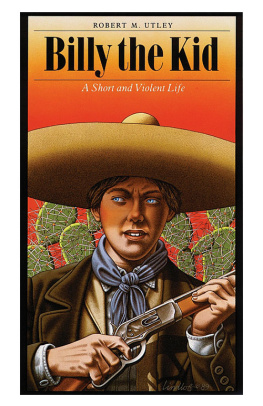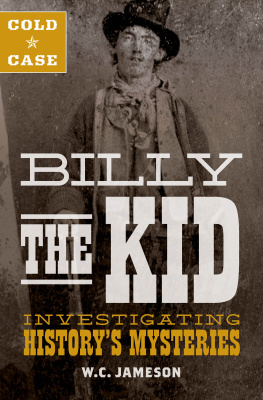2013 by the University of New Mexico Press
All rights reserved. Published 2013
Printed in the United States of America
18 17 16 15 14 13 1 2 3 4 5 6
THE LIBRARY OF CONGRESS HAS CATALOGED THE PRINTED EDITION AS FOLLOWS:
Chamberlain, Kathleen (Kathleen P.)
In the shadow of Billy the Kid : Susan McSween and the Lincoln County War /
Kathleen P. Chamberlain.
pages cm
Includes bibliographical references and index.
Summary: Chamberlain argues that the focus on Billy the Kid has discouraged broader interpretations of the Lincoln County War; she provides a womans perspective of the historic event and places Susan McSweens life and legacy into the larger context of New Mexico history and of womens experiences in the late nineteenth and early twentieth century SouthwestProvided by publisher.
ISBN 978-0-8263-5279-8 (pbk. : alk. paper) ISBN 978-0-8263-5280-4 (electronic)
1. Barber, Susan McSween, 18451931.
2. WomenNew MexicoLincoln CountyBiography.
3. Billy, the KidFriends and associates.
4. Lincoln County (N.M.)History19th century.
5. Lincoln County (N.M.)Biography.
I. Title.
F802.L7C47 2013
978.96404092dc23
[B]
2012037291
ACKNOWLEDGMENTS
I BECAME INTERESTED IN SUSAN MCSWEEN BARBER AFTER MY FIRST VISIT to Lincoln, New Mexico, in 1980. At the time I wondered how she could have played such a major role in the Lincoln County War and yet escaped historical attention. I started to research Susan seriously when I was a graduate student working toward a masters degree ten years later but was often reminded that the Lincoln County War was not a sufficiently scholarly topic for a budding academic, presumably because it was linked to Billy the Kid and hence popular history. Thus, I relegated New Mexicos cattle queen to my things to do list and slowly researched her life while writing a masters thesis, doctoral dissertation, and three books and embarked on a heavy university teaching schedule. As a result, this book is my labor of love. Because it took more than two decades to complete, I saw many of the important archives moved to different locations, renamed, digitized, and even privatized, thus making the endnotes and bibliography a nightmare at times. Still, the slow, steady trail led me to many wonderful people, whom I might not otherwise have met. So the axiom There are no coincidences in life indeed seems true here.
One of these wonderful people was the late Nora Henn, who befriended, inspired, and encouraged me every step of the way. Ironicallyand sadlyI was typing my dedication to her when the telephone rang with news of her passing in May 2011. Nora had moved to Lincoln in 1965 with her artist husband Walter and become a true expert on this regions history. Over the years she generously shared her research and insights with me and with others who, like me, longed to know more. Unfortunately, her massive research on Lincoln, its players, and New Mexicos Santa Fe Ring never led to a book of her own, but it eventually filled notebooks and files. She opened all of this to me, and each summer over plates of cheese and glasses of wine, Nora unselfishly shared her own conclusions. It was Nora who reminded me often that despite everything written on Lincoln County, there remains little on the women or the Hispanic majority.
Another who diligently assisted me in the early days was the late Sam Shepard, librarian at the U.S. Bureau of Mines in Denver. His longtime hobbyindexing western history magazines and booksproved a treasure trove. He also taught me to navigate federal and territorial archives. My mentors at the University of ColoradoDenver, Tom Noel and Mark Foster, introduced me to the wealth of newspapers and other available sources and to the staff of Denver Public Librarys Western History Collection, who always proved eager to assist.
Over the years I discovered more scholars delving into previously popular history topics such as the Lincoln County War. Richard W. Etulain, a mentor at the University of New Mexico, where I obtained my PhD in history, and director of the Center for Southwest Studies, helped me compile Billy the Kid and the Lincoln County War: A Bibliography, which contained more than nine hundred works on the subject. This became my working bibliography. He and othersespecially Margaret Connell-Szasz, John Kessell, and the late Ferenc Szasz and Gerald Nashtaught me to focus on the larger social issues that had so frequently been overlooked.
Among the reviewers for the Bibliography were Paul A. Hutton, a UNM historian of the frontier West, whose own interests often blur the line between academic and nonacademic history, and Robert M. Utley, retired chief historian of the National Park Service and author of several books on Billy the Kid and the Lincoln County War. Another reviewer was Frederick Nolan, undoubtedly the leading historian of the Lincoln County War. A professional writer and novelist, Fred first researched John Henry Tunstall and authored a biography in 1965 on the Englishman whose death sparked the war. Since then he has published numerous well-documented books and articles on Billy the Kid, the Lincoln County War, and related subjects. His writing ability is about as good as it gets, and his enthusiasm and sense of humor are contagious. Fred is unwavering in his support and has inspired me more than he will ever know.
Many more have assisted with my research. Karen Mills, historian in the Lincoln County Courthouse in Carrizozo, introduced me to Robert and Dorothy Leslie and Claude Hobbs, all of whom knew and remembered the elderly Mrs. Barber and kindly shared their memories. Karen also helped me uncover documents and newspapers, sent e-mails, and occasionally treated me to some new discovery, update, or answer to a question. She insists that she is not a researcher but a reader, so I hope she enjoys this long-awaited book. I express my appreciation to Roberta Haldane, who sent articles and then a whole stack of primary sources on Susan that helped me more effectively piece together the cattle queens final decades. Her first book, Gold-Mining Boomtown: People of White Oaks, Lincoln County, New Mexico Territory, was published in May 2012, and we have shared notes and conversations about the pitfalls of publishing. Drew Gomber, whom I met when he worked for the Lincoln Heritage Trust Museum, assisted me with the trusts documents. Perhaps after reading this book, he will stop referring to Susan as Lincolns favorite bimbo.








